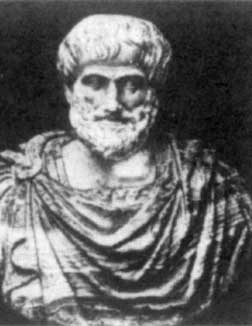Early Greek Astronomy
 The Milesians
The Milesians
The first recorded important contributions to Greek science are from the city of Miletus, near the coast of what is now Turkey, beginning with Thales in about 585 B.C., followed by Anaximander about 555 B.C., then Anaximenes in 535 B.C. Milesians were the first to do real science, immediately recognizable as such to a modern scientist.
Anaximander's suggestion that the earth was actually a cylinder, and the sun, moon and stars were located on concentric rotating cylinders. This is the first recorded attempt at a mechanical model of the universe. He postulated that the stars themselves were rings of fire. Again, this was a revolutionary suggestion, as all heavenly bodies had previously been regarded as living gods.
 Pythagoras
Pythagoras
Pythagoras was born about 570 B.C. on the island of Samos, less than a hundred miles from Miletus, and was thus a contemporary of Anaximenes. Pythagoras is of course most famous for the theorem about right angled triangles, that the sum of the squares of the two sides enclosing the right angle is equal to the square of the long side, called the hypotenuse. Although the theorem, now known as Pythagoras's theorem, was known to the Babylonians 1000 years earlier he may have been the first to prove it.
Pythagoras visited Thales in Miletus when he was between 18 and 20 years old. By this time Thales was an old man and, although he created a strong impression on Pythagoras, he probably did not teach him a great deal. However he did contribute to Pythagoras's interest in mathematics and astronomy, and advised him to travel to Egypt to learn more of these subjects. Thales's pupil, Anaximander, lectured on Miletus and Pythagoras attended these lectures. Anaximander certainly was interested in geometry and cosmology and many of his ideas would influence Pythagoras's own views. In astronomy Pythagoras taught that the Earth was a sphere at the center of the Universe. He also recognized that the orbit of the Moon was inclined to the equator of the Earth and he was one of the first to realize that Venus as an evening star was the same planet as Venus as a morning star.
 Aristotle
Aristotle
In 367 BC Aristotle, at the age of seventeen, became a student at Plato's Academy in Athens.
Although in many areas Aristotle advocated a modern scientific approach and he collected data in a scientific way, this was unfortunately not the case in astronomy. His astronomical
views were biased towards absolute
symmetry, simplicity and perfection. Aristotle, proposed models where the stars, Sun, Moon, and planets are attached to spherical transparent shells undergoing uniform circular motion around the Earth. This is known as a Geocentric Universe. He was correct however about the spherical nature of the Moon, Sun and Earth.